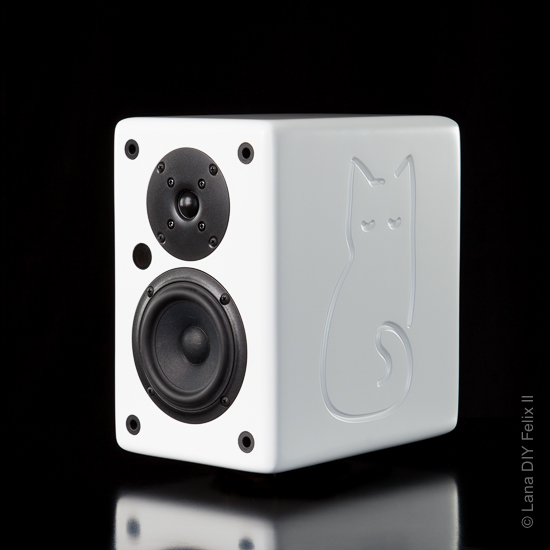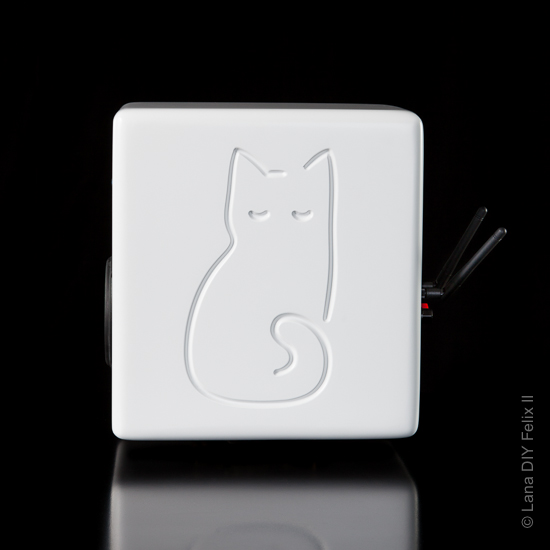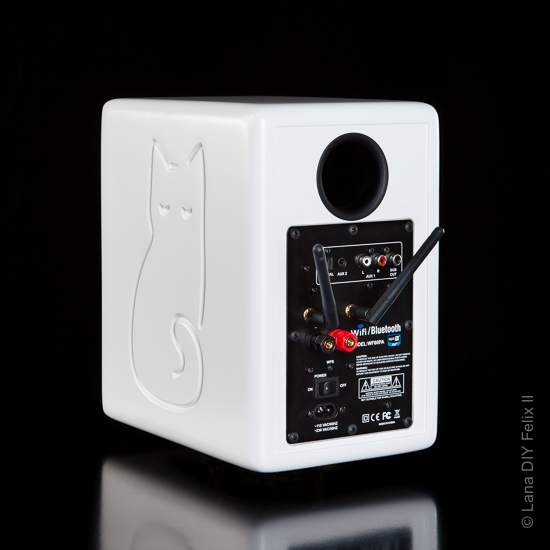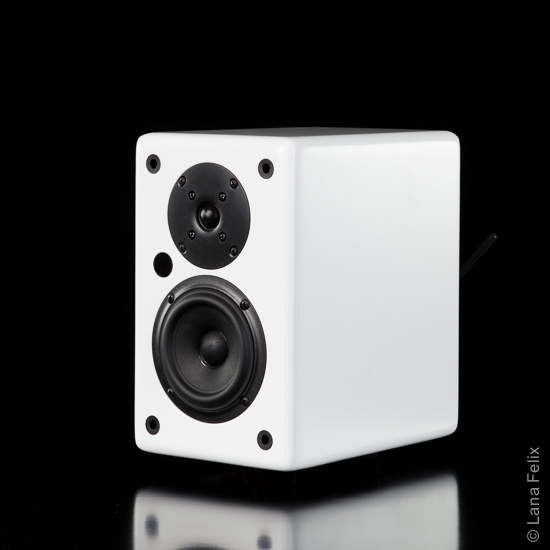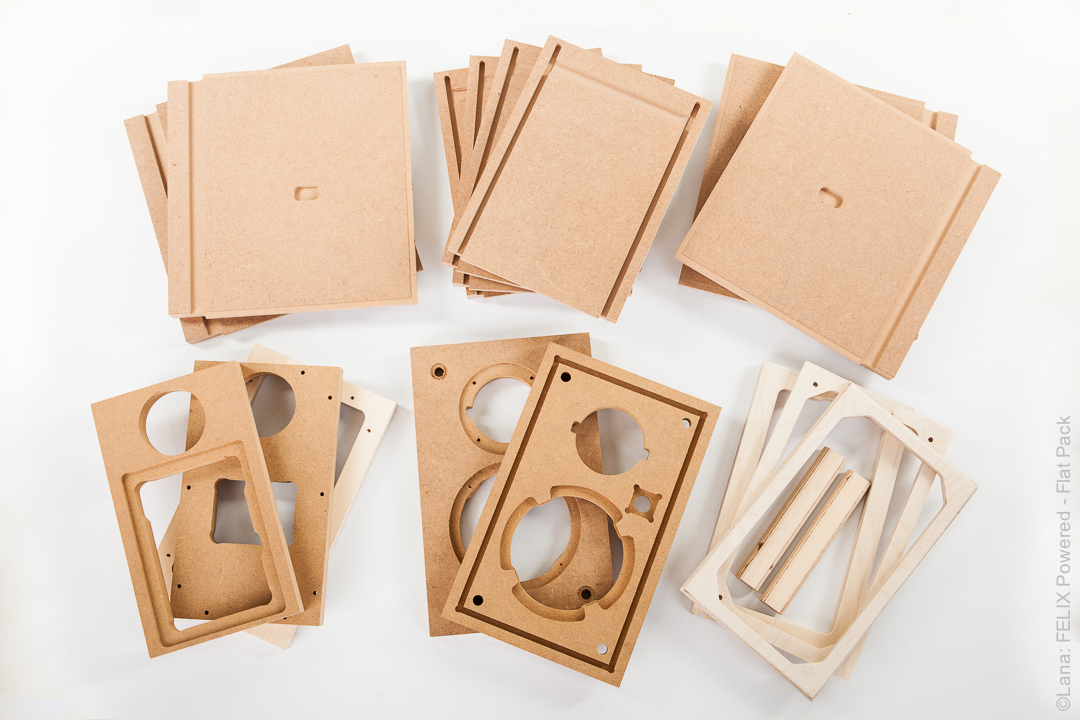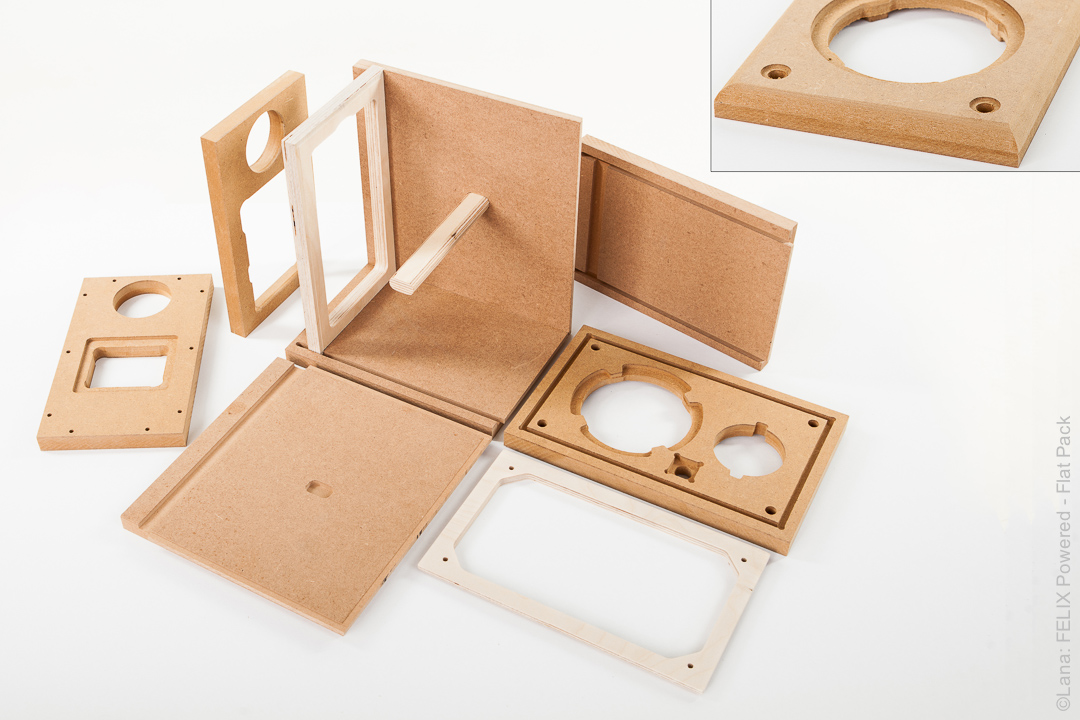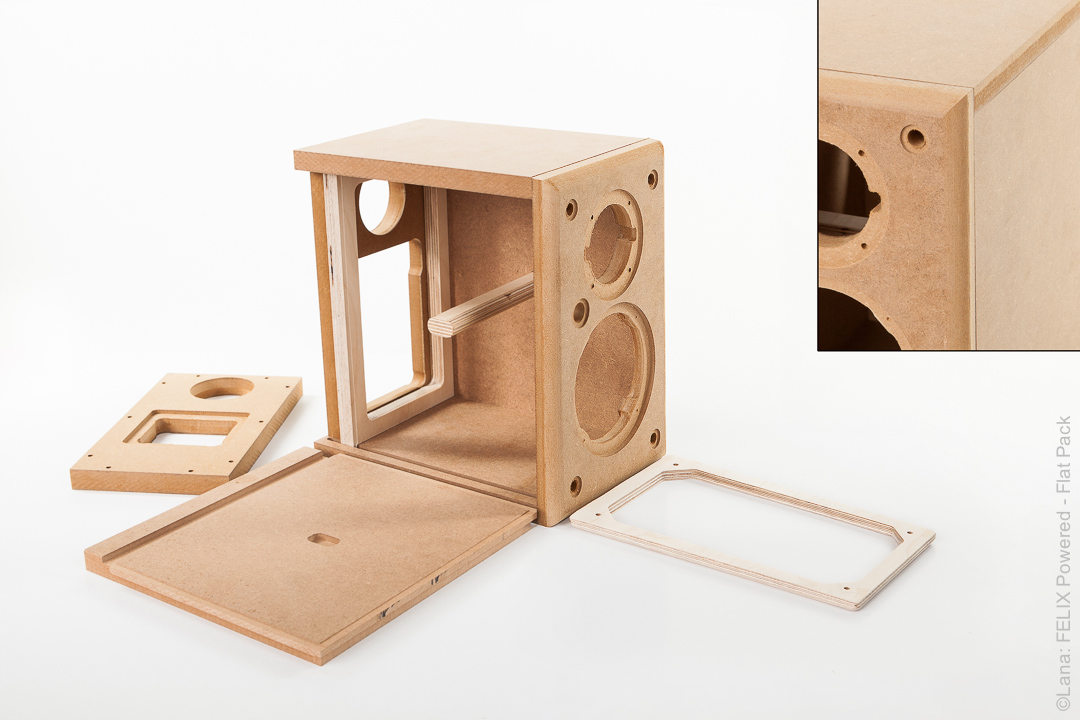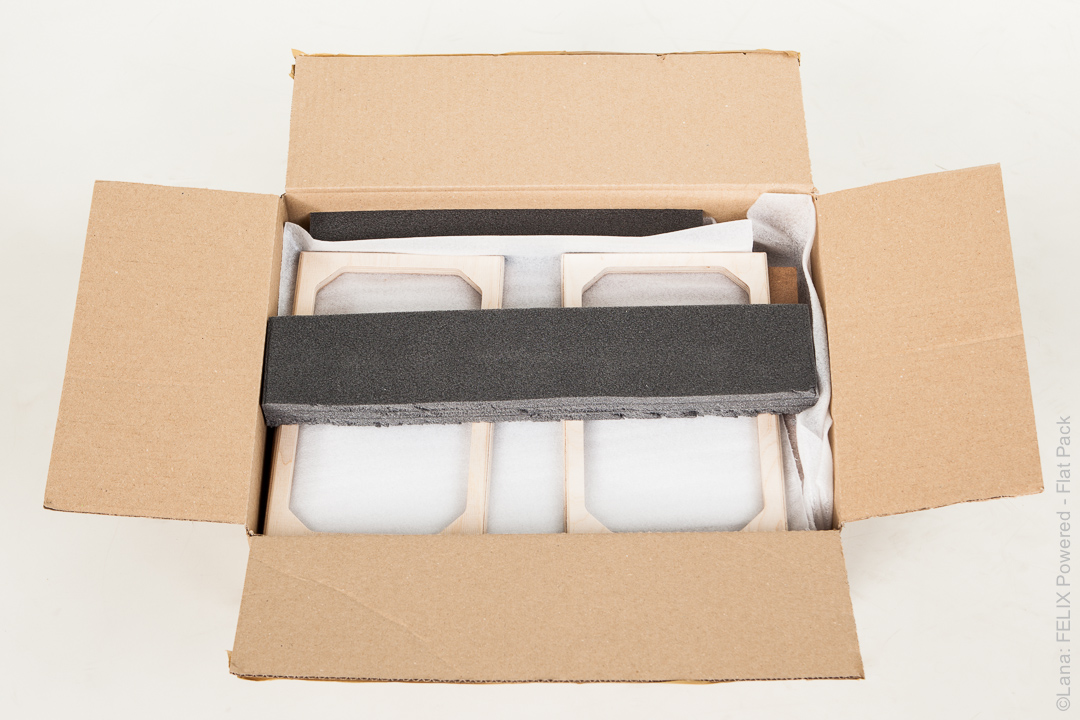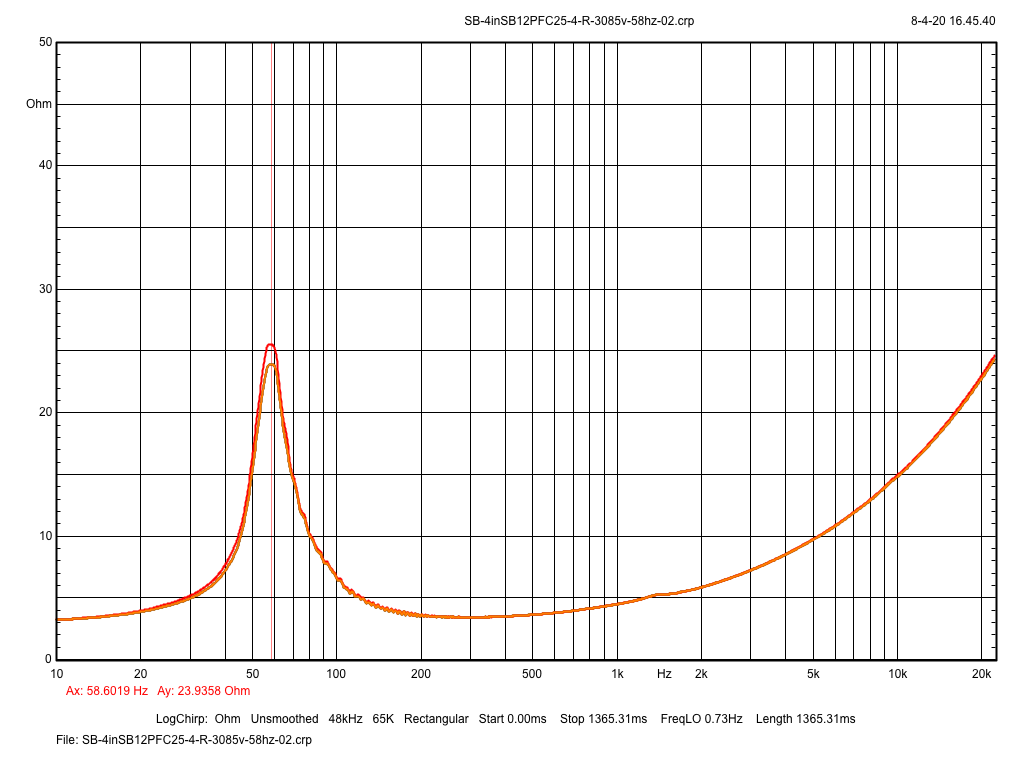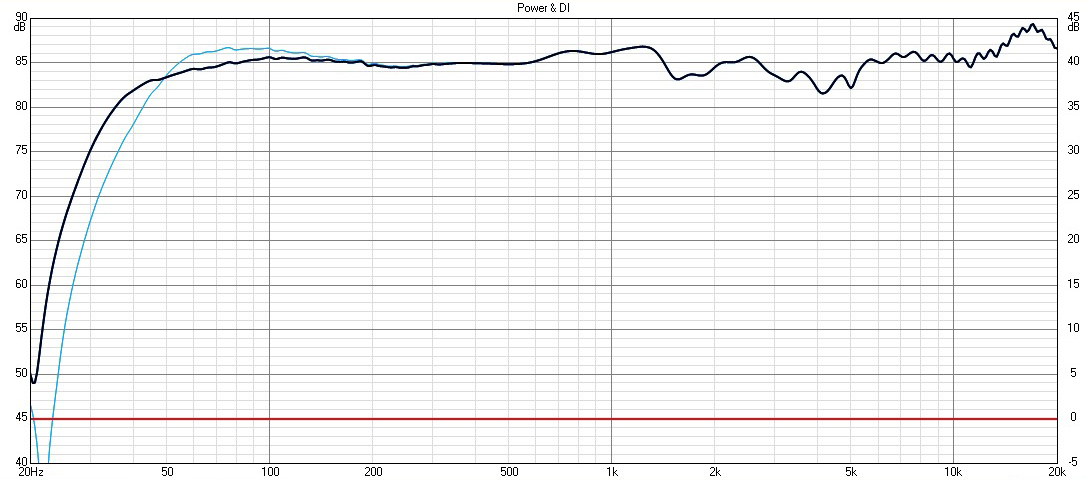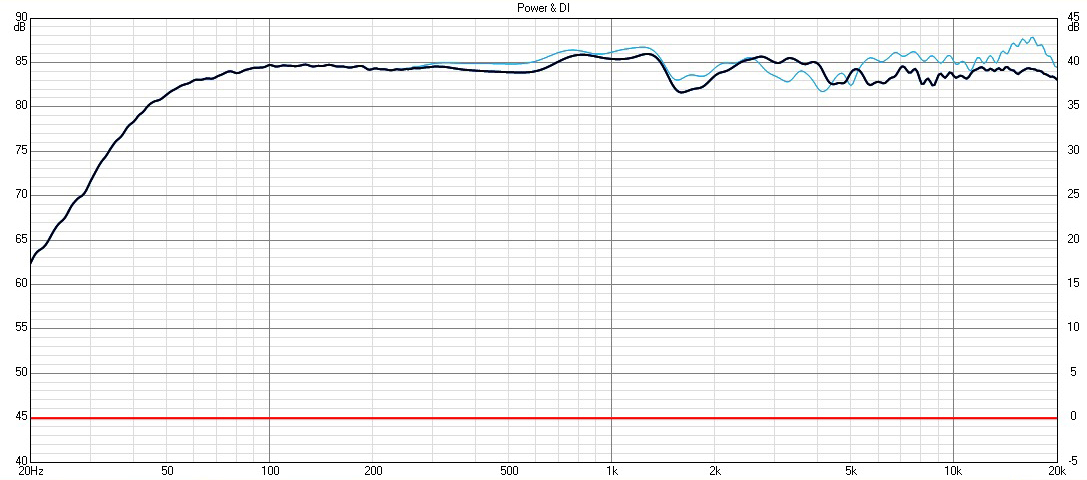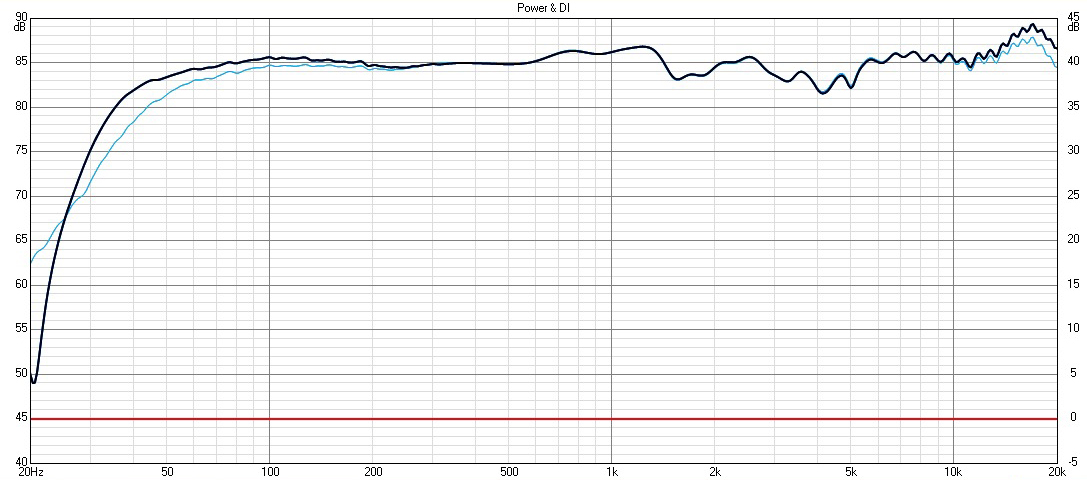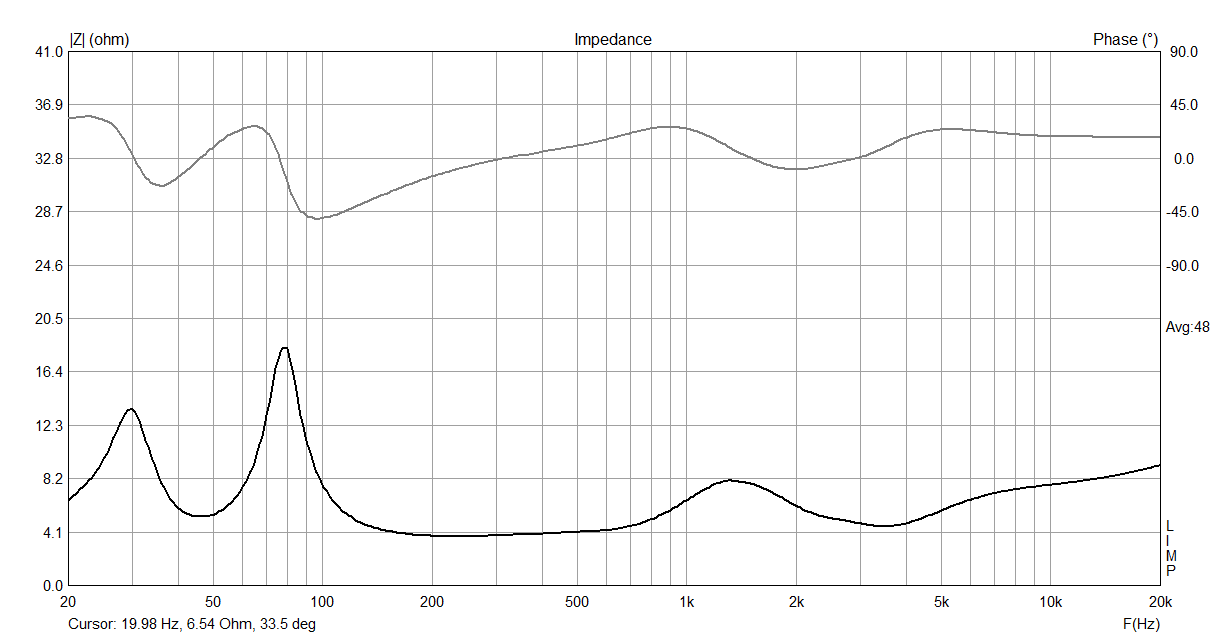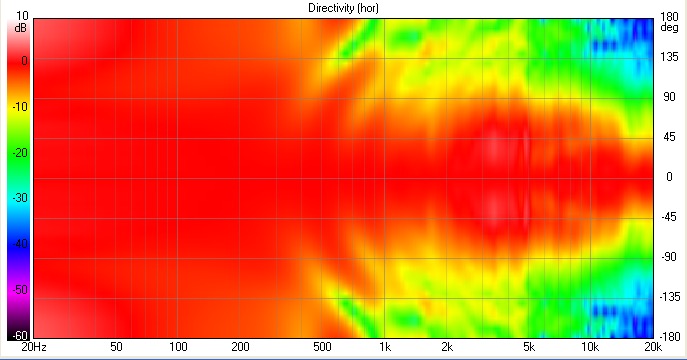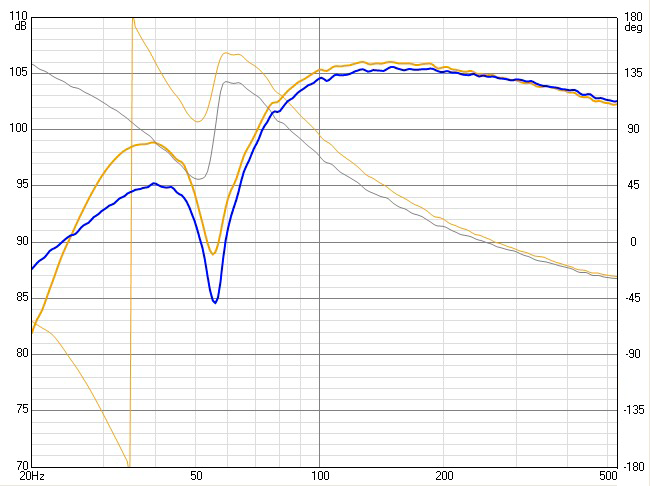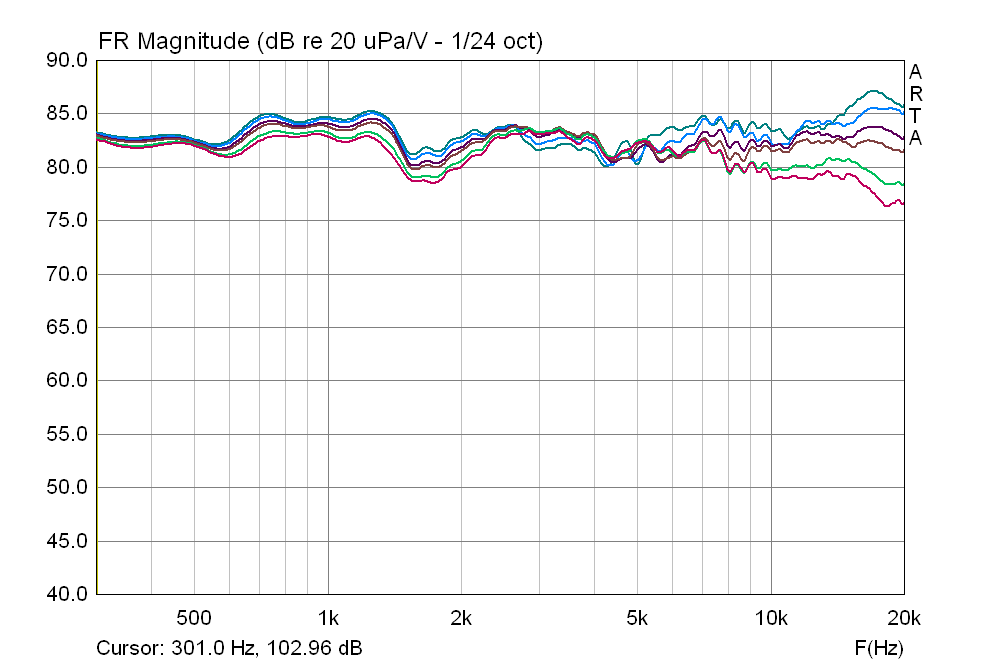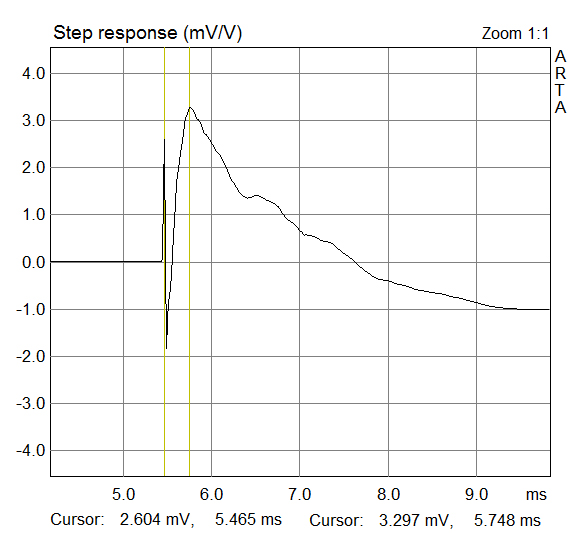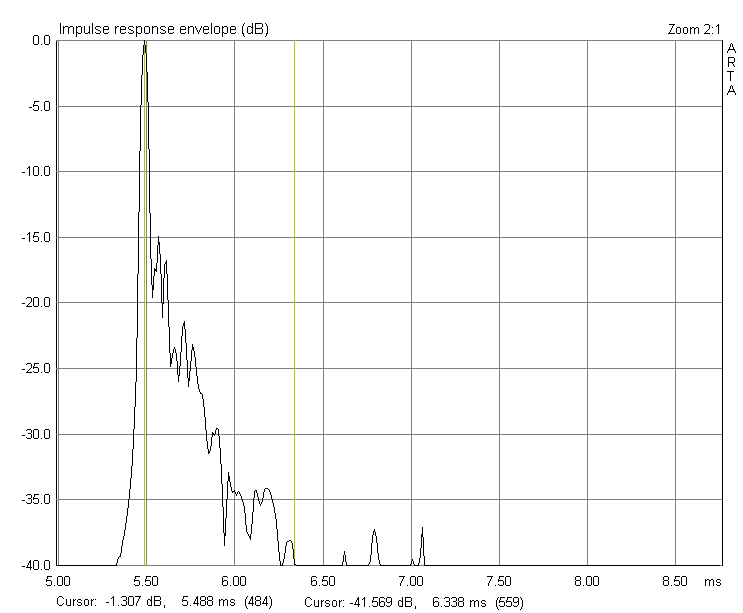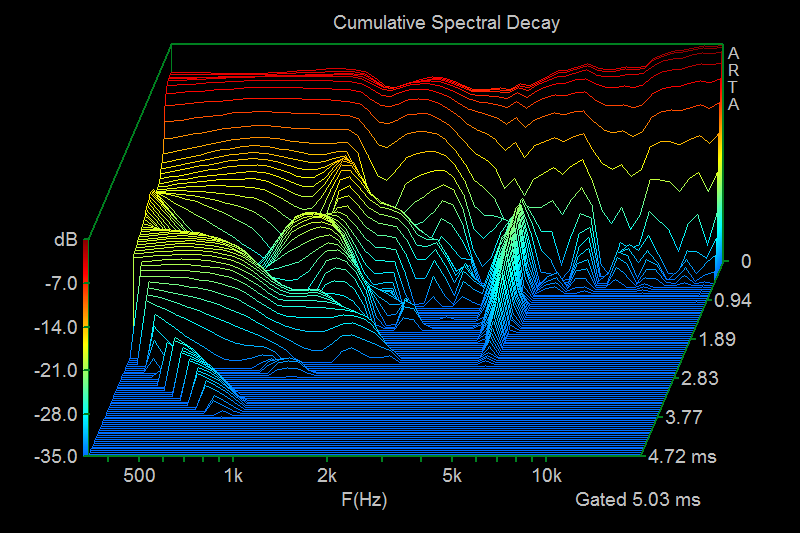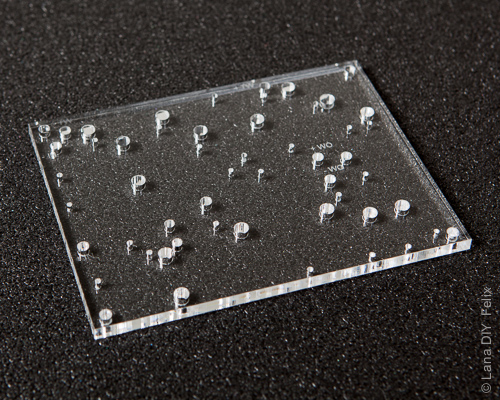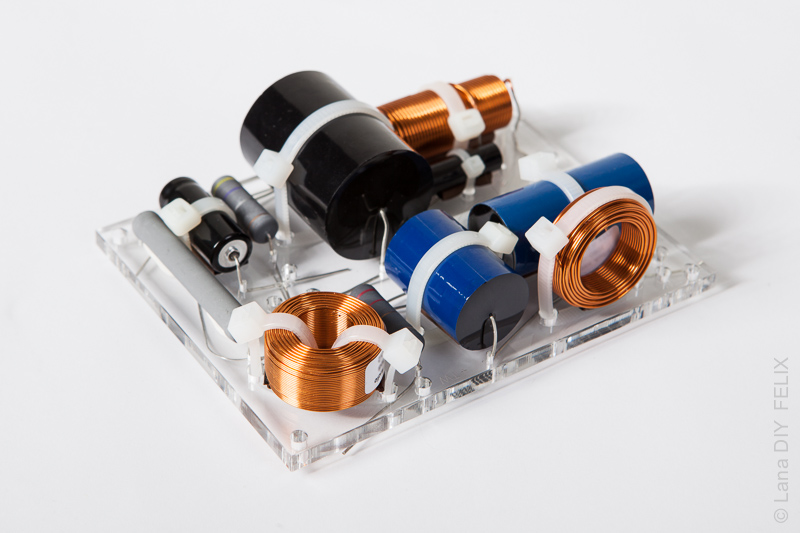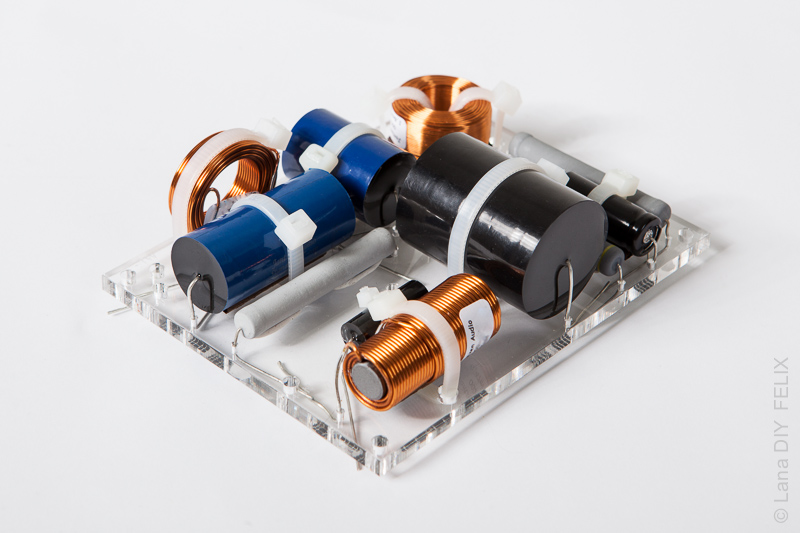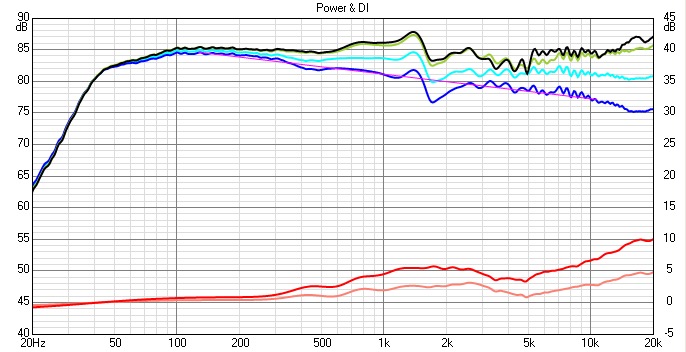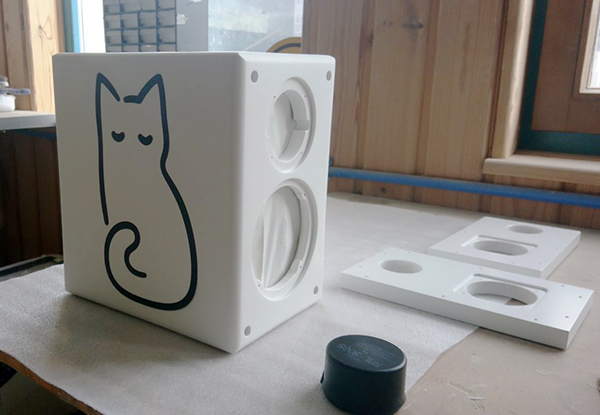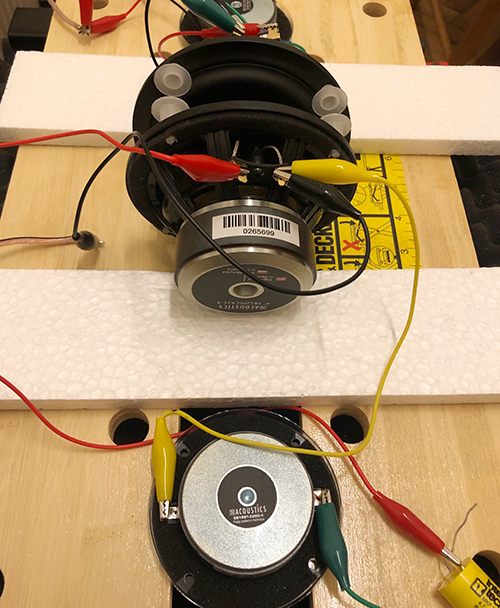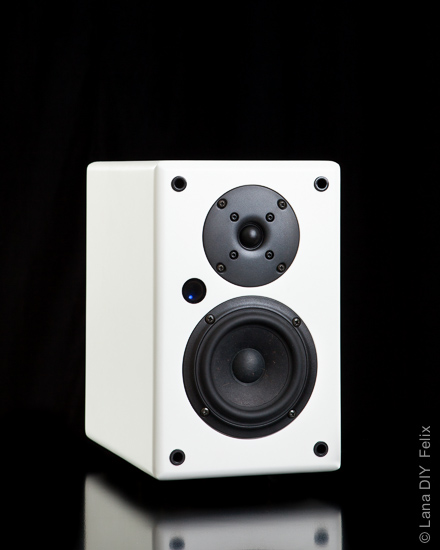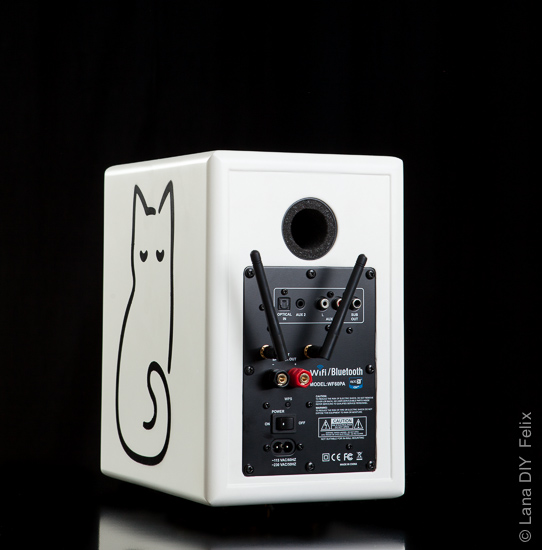Felix Powered
(for Liliana)
2 way Powered Speaker with Bluetooth WiFi wireless connectivity and Optical Input
IT: Cassa acustica amplificata a 2 vie e con Bluetooth, WiFi e ingresso Ottico
— Felix PASSIVE VERSION HERE! / Versione Passiva quí! —

VALUABLE SOUND QUALITY AVAILABLE TO EVERYONE!
The FELIX is designed to be able to work well in different kinds of installations: on desk, on stands, on a bookshelf and for both near and far field listening. The Speaker has a pleasant natural timbre and it gives us a detailed but not tiresome listening experience. Furthermore it’s capable to reproduce an accurate soundstage that allows us to well perceive the location of the instruments in the three dimensional space. Middle, mid-high and high frequencies are ‘promptly’ reproduced, the extension at the high frequencies is considerable and also gives a significant articulation, in fact the FELIX is able to recreate the finer details of the musical recording, giving us a rather ‘rich’ sound. Surely we cannot rock the house with a 4” driver but considering the physical dimensions of the speaker the low end is surprisingly extended, accurate and fast. (in room placement we can get around 44 hz at -3db). Also with movies this speaker can work well.
Felix speaker is with drivers burn in, individually measured and matched!
Ideal ear height is between Tweeter and Woofer, mainly in near field listening.
If you want to build the Felix.
The Felix Powered is available as:
- Assembled with Sand Paint Finish (pair): 730,00€ per pair. VAT. Speaker is with drivers burn in, individually measured and matched.
— Sand Paint Finish is a less sensitive type of coating typically used in Pro Audio Speakers —
- Assembled with Painted Matte Finish (pair): 785,00€ per pair. VAT. Speaker is with drivers already burn in, individually measured and matched.
Contact me if you want to buy a fully assembled Felix!
All prices may be subject to change.
— Please Note: Crossover components’ values come with the purchase of the DIY Kit —
DETAILS / CARATTERISTICHE:
- 2-way vented speaker system, 4” SB Acoustic mid-bass and 0,75” SB Acoustic soft dome tweeter
- drivers and crossover components are individually measured and matched
- drivers are burned in (There is no need to wait a few months to get them to sound their best)
- 6,4 net liters vented cabinet (virtually ~7,2 liters)
- System sensitivity: ~86 db/2.8v, 1 meter
- Frequency resp.: 47 – 30.000 Hz (-3db) – Typical in-room response ~44 Hz (-3db)
- Acoustic point of crossover: 3000 Hz
- Cabinet Dimensions: 17.2 cm wide, 27.2 cm high, 25.3 cm deep
- Power: 30 + 30 Watt rms
- Bluetooth 4.0 (with aptX®) wireless connectivity
- Wi-Fi (Hi-Fly App Control and AirPlay©, DLNA compatible and Multi Room)
- Support: MULTI-ROOM (Play synchronized audio in multiple rooms for seamless listening), MULTI CHANNEL (Play any song to any single device or group devices together) and MULTI USER (Different users can control the audio source for different devices)
- Selectable optical (S/PDIF – Toslink), RCA, and 3.5 mm inputs for traditional wired connections
- Full feature wireless remote for simple, convenient operation
- Signal sensing standby mode automatically powers down amplifiers after 15 minutes of inactivity
- RCA mono subwoofer output (80 Hz Xover, the speaker outputs remain full-range) makes it easy to add a powered subwoofer
- Control music player from remote (PLAY, PAUSE, PREVIOUS, and SKIP) in Bluetooth mode
- Rounded edges to reduced Baffle Diffraction
- Internal Bracing to reinforce the structure and to reduce and distribute cabinet vibrations and therefore lower sound coloration
- Chamfered Woofer cut-out inside the Baffle to aid airflow behind the driver and reduce Diffraction
- Drivers and Catchers are Flush-Mounted to avoid unwanted Diffraction
- High quality Crossover components
- Gold Plated Terminals
- Friendly and versatile placement in domestic room
- Back firing port to reduce any possible Vent noise to listeners
———-
Contact me if you want to buy a fully assembled Felix or a DIY Kit!
THE FELIX SPEAKER CAN BE MADE CUSTOM FINISH WITH ENGRAVING.
——-
HERE AN EXAMPLE MADE WITH THE CAT DRAWING AND IT’S AN OPTION, OTHERWISE THE CABINET IS WITHOUT ANY DRAWING.
(click to enlarge)
Felix Powered Speaker in full white matte finish!
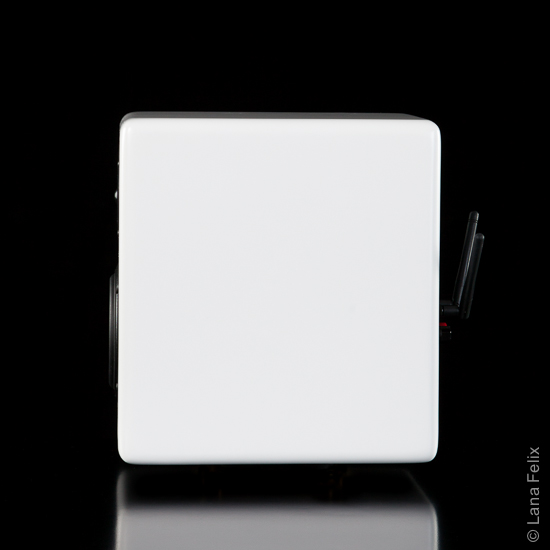
(click to enlarge)
The Cabinet is made in collaboration with the Great Team of SafeCase 🙂!
High Quality MDF Cabinet as Flat Pack
Rounded Baffle to reduced Baffle edges Diffraction
Internal Bracing to reinforce the structure
Chamfered Woofer cut-out inside the Baffle to aid airflow behind the driver and reduce Diffraction
Drivers and Catchers are Flush-Mounted
(click to enlarge)
DRIVERS and PLATE AMPLIFIER
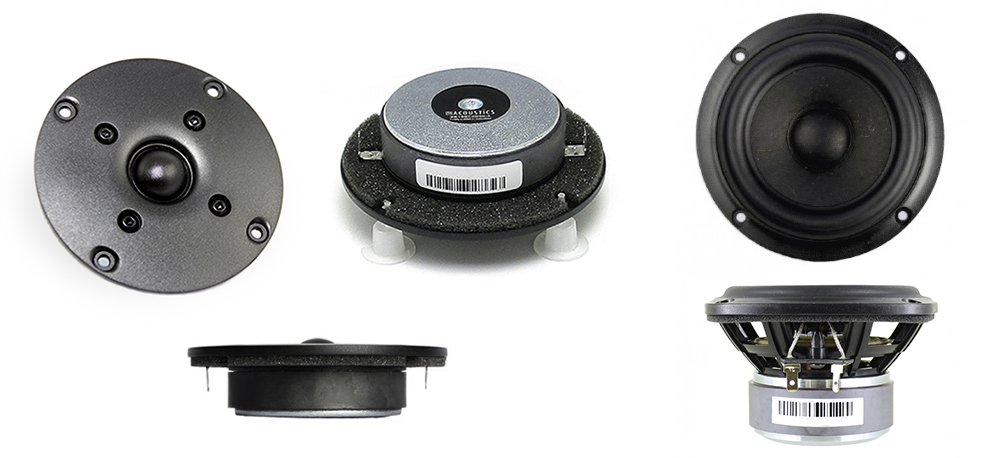
The Drivers used are from SB Acoustic and they have an excellent price / quality ratio: Teeter SB-19ST-C000-4, Woofer SB12PFC25-4-R (click on code for Datasheet). They impressed me and matched with the Felix solid and rounded cabinet construction, with high quality crossover components, connectors and cabling they will give you a lovely music listening experience, despite their little dimension and cost! The Tweeter is very well made and has a great dispersion and out of axis behaving. Nice frequency response and very good distortion that stays low also at 95db level from 3000 Hz up (the crossing point I choose). And the most of all it has a very good sound, pleasant middle high and detailed but not tiresome high frequencies, lovely drive. The mid woofer is also very well constructed, it has a plastic basket that greatly makes the job. A powerful magnet that allows this little driver to have a very “fast ” reproduction and a linear +-5mm excursion. The driver is a 30 watt one so don’t aspect to “brake down the house” but with any 4 inch drivers it wouldn’t make any sense. Still in the Felix this drivers will go down to around 47 Hz -3db, and in room you will get even more. The response is linear till 1000 Hz and from 2200 till 8000 Hz. We have a dip at 1800 Hz that “characterizes” a bit the sound of this driver but in room listening this aspect gets less preeminent as you can see in the in Room measures. The overall good construction and this nice “paper” cone brings to a very pleasant sound and natural. And despite the small size of the driver the SB12PFC25-4-R is capable to give us a fair amount of bass information, precisely and with a good punch at “normal” listening levels. From Klang+Ton Magazine Review: “… the SB12PFC25-4 is still a hot candidate for high-class desk sound systems or a near-field monitor”.
/IT: I componenti della SB Acoustic dal rapporto prezzo qualitá sorprendente: Tweeter SB-19ST-C000-4, Woofer SB12PFC25-4-R
LEFT: Measured Impedance and Phase differences between 2 different Tweeter SB-19ST-C000-4 unit, an excellent match that proves the building quality of SB Acoustic! (click to enlarge) RIGHT: Same great match for the mid Woofer SB12PFC25-4-R! Thank you SB Acoustics!🙂 (click to enlarge)
/IT: SINISTRA: Impedenza e Fase misurata su 2 degli esemplari in mio possessol del Tweeter SB Acoustics SB-19ST-C000-4, la differenza tra le due unitá mostra un risultato eccellente! (clicca per ingrandire) DESTRA: Stessa notevole consistenza dei parametri trai i due esemplari del mid Woofer SB12PFC25-4-R! Grazie SB Acoustic!🙂 (clicca per ingrandire)
Dayton WF60PA Plate Amplifier
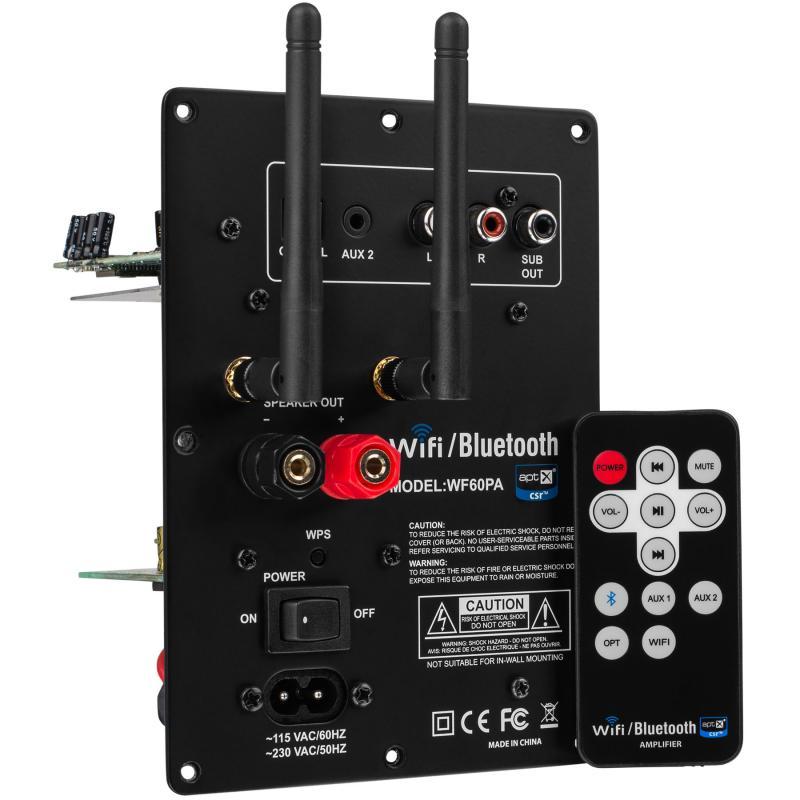
The Plate Amplifier is the very well made and versatile Dayton WF60PA , click for User Manual to see all characteristics. A WiFi/Bluetooth plate amplifier with a 30+30 watts RMS. Here the technical drawings – or here Zip with Manual and Drawings in different formats.
/IT: Il ben costruito e versatile amplificatore della Dayton: Dayton WF60PA , clicca per vedere il Manuale d’uso con tutte le caratteristiche. L’amplificatore é con WiFi/Bluetooth ed é da 30+30 watts RMS. Quí i disegni tecnici – o quí il Zip con Manuale e disegno in diversi formati.
The amplifier is very well constructed and has a pleasant sound. It has many connective possibilities: wireless Bluetooth 4.0 and Wi-Fi (Hi-Fly App Control and AirPlay© and DLNA compatible) and Selectable optical (S/PDIF – Toslink), RCA, and 3.5 mm inputs for traditional wired connections. Also there is a RCA mono subwoofer output with a 80 Hz Xover, the speaker remain full-range. There is also very useful remote control that in Bluetooth mode can PLAY, PAUSE, PREVIOUS, and SKIP the musics stored on your Smartphone.
MEASURES OF THE FELIX POWERED SPEAKER SYSTEM
LEFT: Felix Powered Speaker measured at 80 cm distance with Mic at Tweeter axis. In Black the response with the 2 layers Foam inside the Vent (recommended!) Fb tuning 45.5Hz. Using the Foam we get a more precise and better transient response and also we get a less coil excursion around the 45Hz region and under! In Light Blue without the Foam inside the Vent. RIGHT: In Light Blue the response at 0 deg and in Black at 30 deg. The 30 deg response it gives a better idea of “which response” we will get in a domestic room. Here the measure is without the Dayton and the Boost at low and high frequencies is not shown. (Click to enlarge)
The response is mostly +/- 1.5 dB from 55 Hz and up, there are only 2 lower dips in the 4000-5000 Hz region. Dips that will be partially recovered by the response of the off axis responses. The dip around 1800 Hz is a characteristic of the SB Midwoofer and, as tested, will not be noticeable in the Room listening environment. After the pleasant listening results I decided that is not needed to recover this dip with the crossover, also to avoid a more complicate and expensive crossover. (Click to enlarge)
The acoustic response at low end here is shown with Baffle Diffraction loss that cause a reduction of SPL in the low frequencies (this happens to all speakers). But when a Speaker is placed in the room the lower frequencies will get a „boost” in a quantity that depends on the room sizes, characteristics and on the placement of the speakers. In this way the Baffle Diffraction Loss will be recovered.
As information: the Black measure is the Felix with the Dayton Amplifier and the Light Blue measure is without the Dayton! The Dayton Amplifier has incorporated a boost in the low and high frequencies: the “boost” on the low frequencies starts “slowly” from 200 Hz reaching about +4.3 dB at around 40 Hz. The “boost” on the high frequencies is little and starts “slowly” from 8000 Hz, reaching +1.5 dB at 18000 Hz. Dayton doesn’t specify this boost in the Plate Amplifier specifications.
—————
IN ROOM MEASURES – In different kind of placement at 1/3 Octave!
Despite the different placements we can see how the response from 500/800 Hz and up is always very well controlled and flat!
Everything under 1000/800 Hz is strongly influenced by the Room Characteristics and Resonances!!
40 m2 LIVING ROOM on Stands or next to TV – Room has many furniture, carpet, curtains, books etc.:
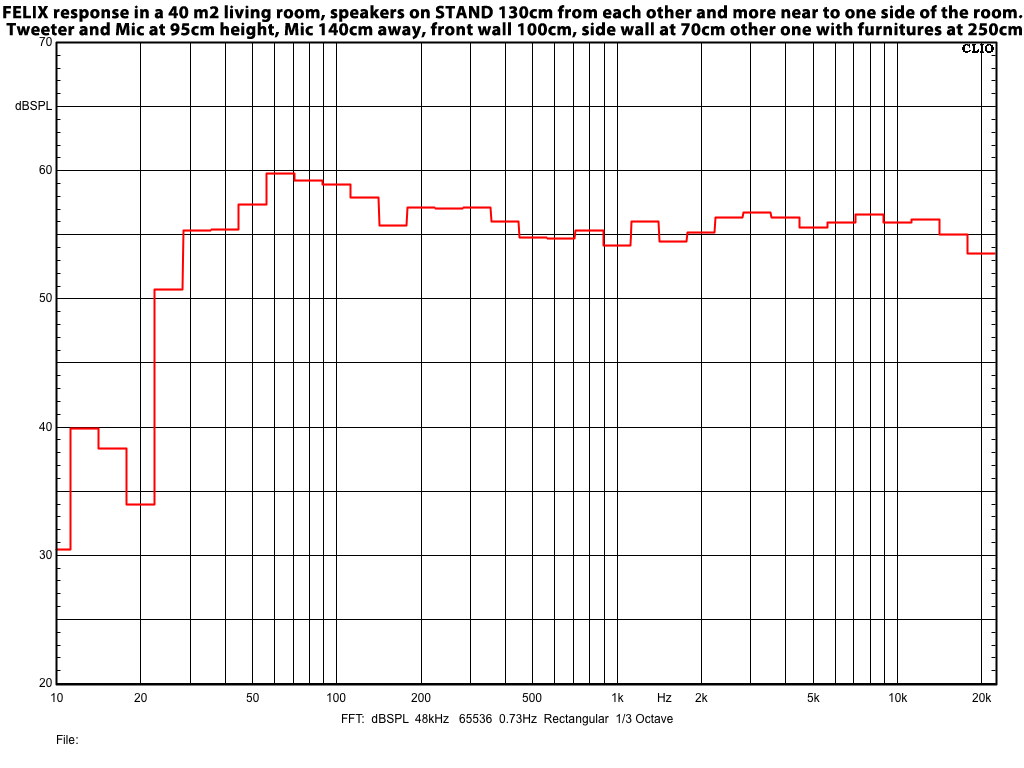
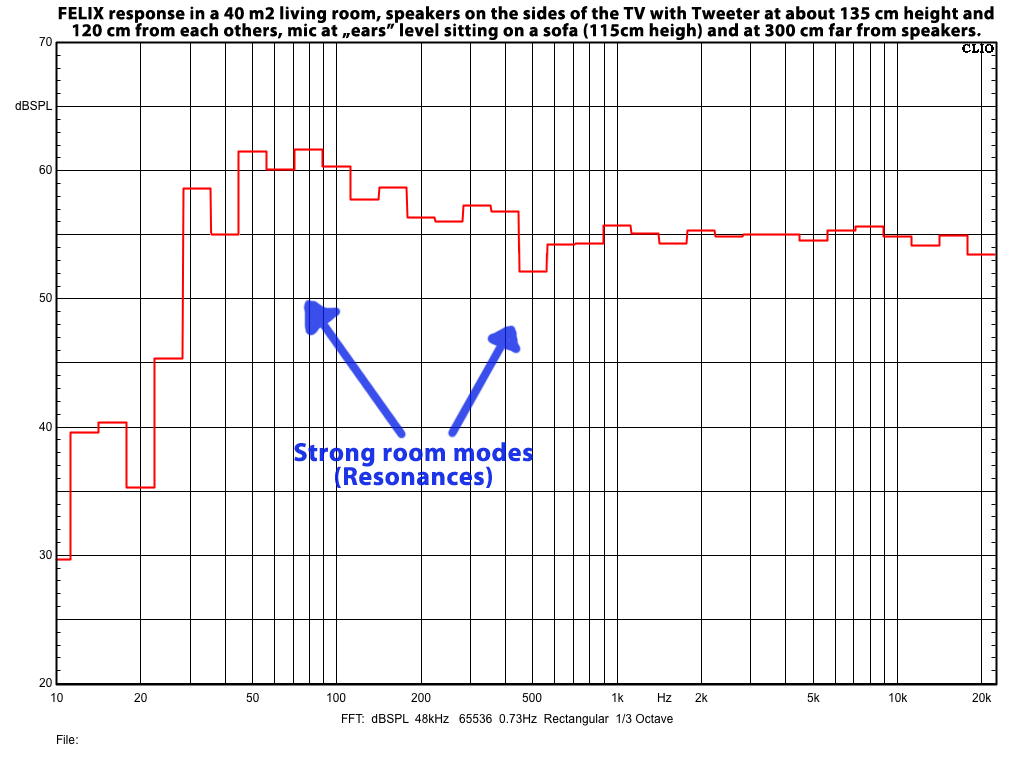
LEFT: Felix Speaker in a 40 m2 LIVING ROOM on Stands: speakers 130 cm from each others, Tweeter and Mic at 95cm high, Mic is 140 cm away, Front Wall 100cm (the one behind the speakers), one Side Wall 70 cm far and the other 250 cm far. 5 deg. toe in. A very well performance! Going more far from the speakers will give us a “more worm” sound.
RIGHT: Speaker placed on the SIDES of TV at 120 cm far from each others in the same 40 m2 LIVING ROOM. Tweeter is at 135 cm height from floor level. Measure is taken at 300 cm far and like if listener is sitting on a sofa. The not acoustically treated room bring to some relatively strong resonances but listening is very pleasant and the reinforcement at the low level gives a nice warm “punch”.
32 m2 LIVING ROOM on Stands – Room is quite empty and no acoustically treated:

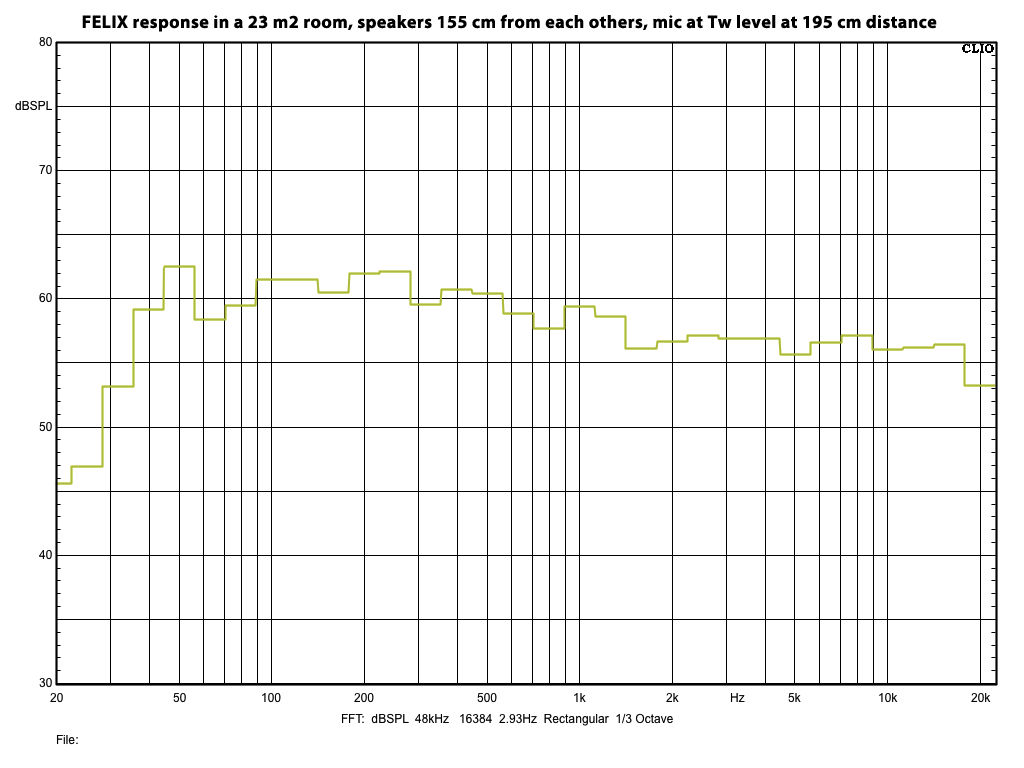
The emphasis at 50 and 250 Hz, and the little dips at 60, 300 and 800 Hz are influenced by Room Resonances. Note as at the more far listening distance the Room Resonances increase farther more the low frequencies region.
LEFT: Felix Loudspeaker is in a *quite empty 23 m2 sized room on Stands. Positioned with the Tweeter at about 1.4 meter away from side walls, 88 cm high, 90 cm away from front wall (the one behind the speakers) and 145 cm away between right and left speaker. Measure is taken from a listening position far 177 cm at Tweeter level.
RIGHT: Same but here speakers are 155 cm away from each others and the listening position is at 195 cm.
We can see that the all response is, even in this “difficult” room, between + – 2.5 dB and this is a very nice performance. The frequency response over 1200 Hz is extremely flat!
*quite empty”: no fornitures, no carpet on the floor (wood floating floor) and with just few absorbent material on some part of the walls. This room bring a response boost that is a bit more then the usual from 500 Hz and down.
Placed on Desk in a 16m2 room partially acoustically treated:
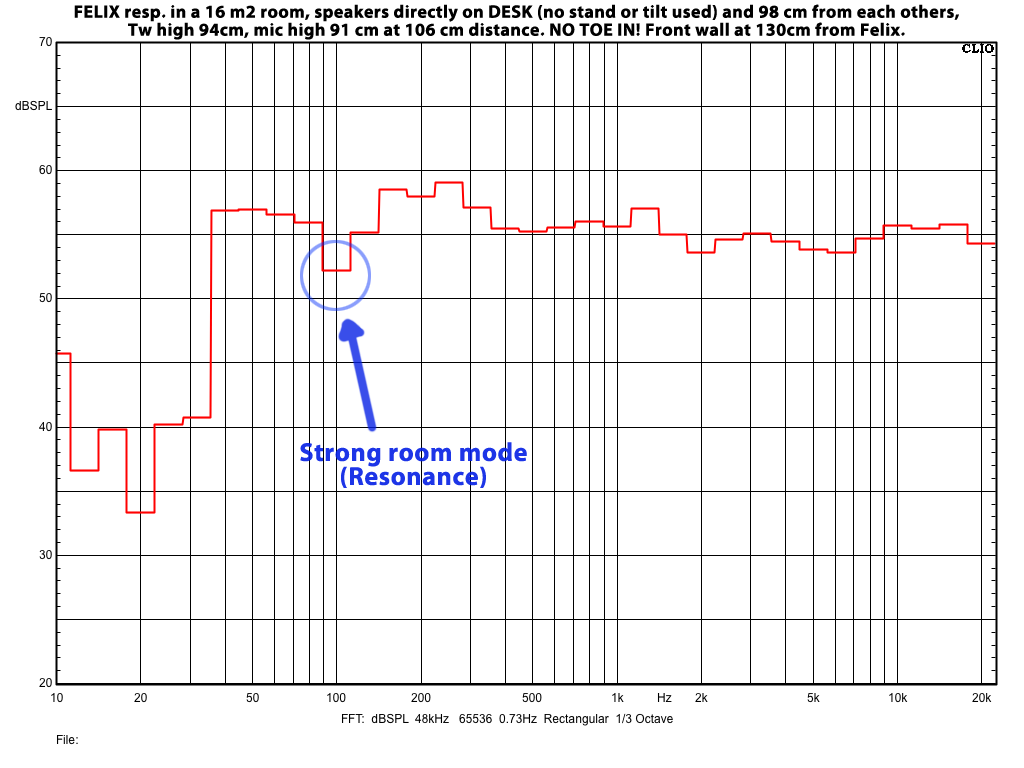
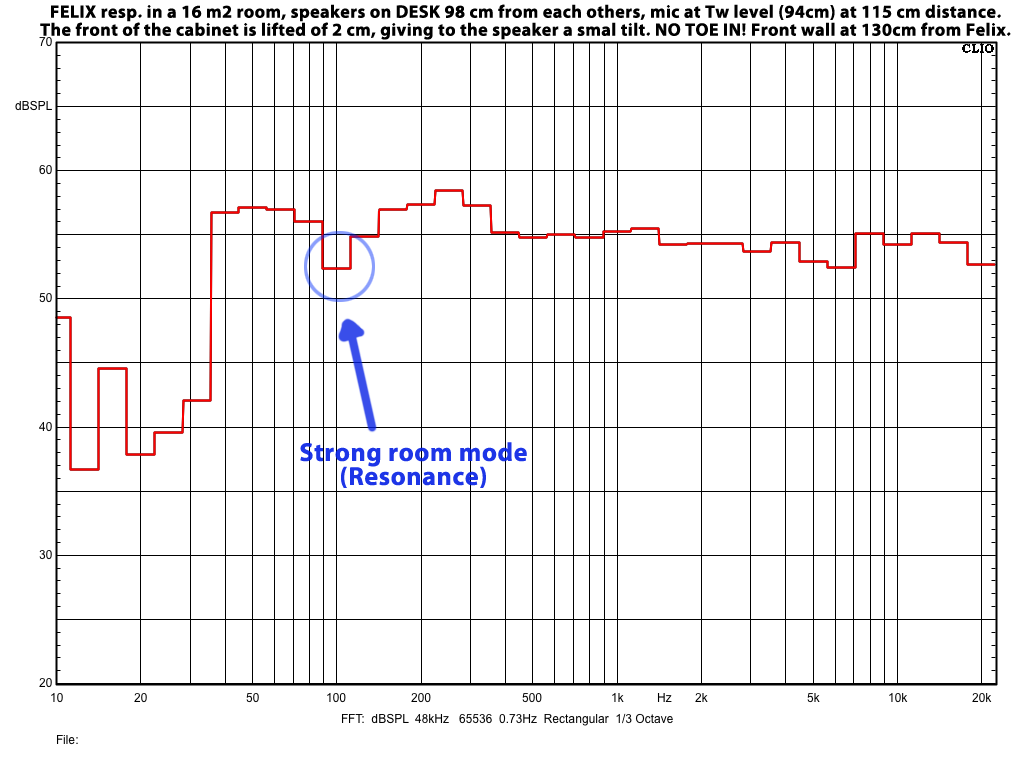
LEFT: Felix Powered Speaker placed directly on Desk, no any Tilt or small stand under the cabinet. Here we see a “Near Field” kind of placement: Tweeter axis is at 94 cm height and listening position is at 91 cm height and 106 cm far, going more far we can get an even more linear response. As sad the “ideal” ear listening level is between Tweeter and Woofer. The Front wall (the one behind the speakers) is at 130 cm from Felix Baffle and we are in a 16 m2 room, No any Toe-In for the Speakers. The +3,5 db in the 200 Hz region is a typical increment caused by the Desk under the speakers, the 3,5 db is still a very acceptable value. Also the little increment from 10.000 Hz and up is given by the Desk reflections.
RIGHT: Speaker positioning same as on the Left but with the front Panel lifted of 2 cm that gives a small Tilt. Listening point is a bit higher then before (94 cm) and more far (115 cm). No Toe-In! If you want to recover a bit the high frequencies just give a Toe-In to the speakers in a quantity that matches your needs.
A lot depend on your room dimensions and characteristics and on where you place your Music Production Desk. You need to try and find the best solution! Is not fault of the speakers if you don’t do your best to find the right placement. 🙂
On top of a Wardrobe with Tweeter at 210 cm height from floor level:
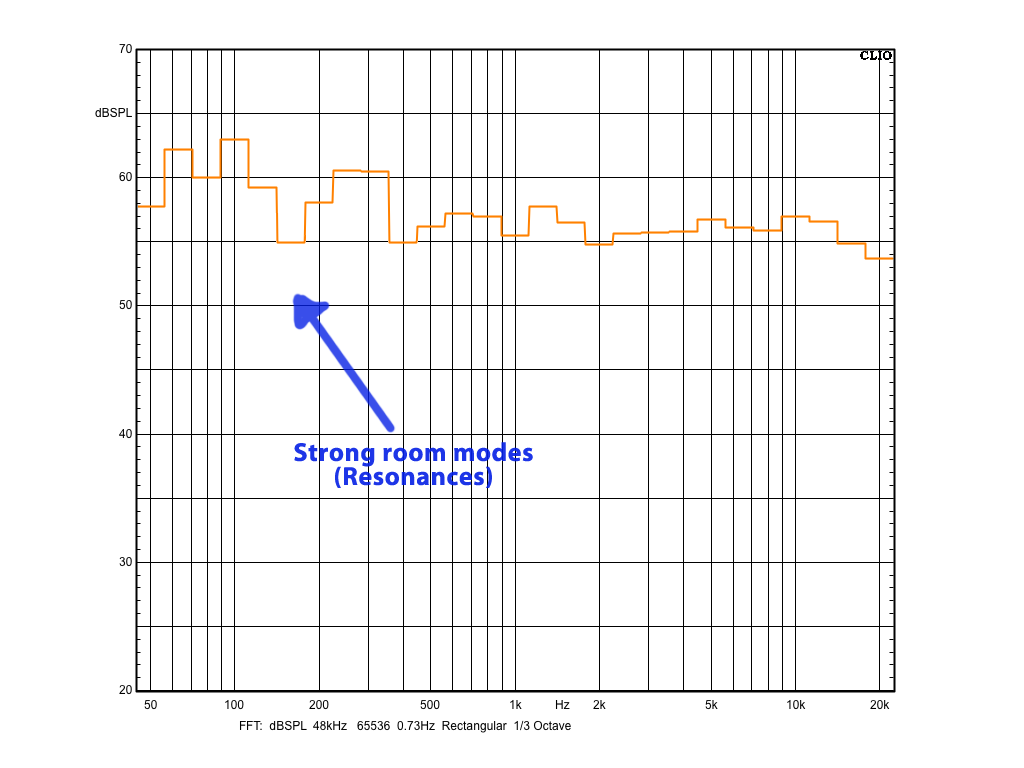
Here a quite extreme placement! The Felix Speaker is placed on top of a Wardrobe with Tweeter at 210 cm height and 100 cm from each others. Tweeter is only 52 cm under the ceiling and wall behind the speaker is at 30 cm. Listening position here is 300 cm far and at 140 cm from floor level. I choose this height between sitting and standing as it shows a good approximation of both. We can see that Felix has also a good Vertical Dispersion characteristic.
Measures from 35 Hz and down are influenced by environmental noises.
MORE MEASURES AND VENT TUNING
VENT TUNING!
The Dayton Amplifier has a Boost in the low frequencies and to “control” it a bit I tuned the Reflex in a way to get a “more damped” behavior, to avoid a too “loose/prominent” Bass response. This goal is also achieved with the use of the Foam piece inside the vent, use that I recommend! With the Foam we have a more precise response and better transient!
An extra good thing is that we have 2 choices:
- A “more forward” bass reproduction but less controlled – Use the Felix without the Foam
- A more balanced and precise bass reproduction – Use the Felix with Foam
Depending on your needs, room and listening “taste” you can use the Powered Felix with or without Foam.
———————
LEFT: Electrical Impedance and Phase that shows that the Felix is for the Dayton amplifier an “easy speaker” to drive, considering that it’s a 4 ohm speaker. We have the maximum negative electrical phase at 96 Hz with -51 Deg and 8.70 ohm. We should get the maximum load for the amplifier around the 130 Hz where we have 4.70 ohm and -38 deg. The lowest impedance is at 230 Hz with 3.77 ohm and a very friendly -9 deg. Above 230 Hz the negative Electrical Phase never go under -9.5 Deg. The measure is taken with the 2 layers of Foam inside the Vent. Fb Vent Tuning 45.5 Hz. (Click to enlarge) RIGHT: Polar Map Directivity, horizontal. (Click to enlarge)
Polar Map Directivity shows that the Felix has a controlled directivity and therefore the Speaker has a friendly interaction with the room. You can easily place it in your domestic environment and in different kinds of installations and keep a quality sound reproduction! See also under in the Crossover Scheme section: Listening Window, Early Reflections, Power Response, Directivity Index Results!!
LEFT: Near Field response of the Woofer SB12PFC25-4-R in the cabinet. Vent is without Foam, Fb Vent Tuning 55Hz. Blue is without the Dayton Amplifier Module connected to the Speaker. Orange is with the Dayton Amplifier connected to the Speaker. You can clearly see the Boost starting from 220 Hz and down. We can also see that the Dayton has a kind of Subsonic Filter under 30 Hz. This is a very good thing so not to waist power trying to reproduce very low frequencies that anyway we are not able to ear with a small sized speaker. (Click to enlarge) RIGHT: Measure at 80 cm distance with Mic at Tweeter Axis, the measure is gated and accurate from 300 Hz and above. At 0 – 15 – 25 – 30 – 40 – 45 degrees. (Click to enlarge)
LEFT: Step Response of the Felix, we can see how the Tweeter is very fast and doesn’t show any tales, the Woofer is delayed of only 0,285 ms from the Tweeter. (Click to enlarge) RIGHT: The Impulse Response gets down to -45 dB in 0.85 ms, this is a very good performance! And it does it in a quite “clean” way, being not too jagged. Then there is a very shallow peak coming back at around 1.3 ms at a low level of -37 dB. The Impulse gets down to -48 dB from 1.6 ms. A very nice result! (Click to enlarge)
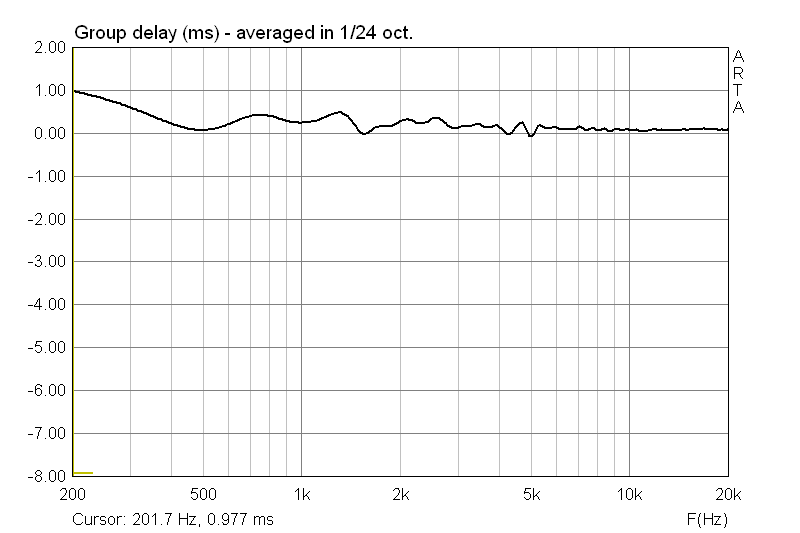
Group Delay measure of the Felix speaker system, measured with Arta.
LEFT: Cumulative Spectral Decay Waterfall of final speaker set to -35db and no Smoothed. Click to enlarge RIGHT: Same but Sonogram representation. From 1.700 Hz up the -35 db is reached very fast in 1.7ms or less, a nice result, there are some coming back reflections at 1.700-2.000 Hz (of low entity) that goes again to -35db at around 2.4ms. We can see how the impulse from 2.000 Hz and up is going down to -35db for the first time at already 1.1ms or less. We can see how middle high frequencies (2.000 to 20.000Hz) are going down to -35db for the first time at already around 1.15ms or less. Over 5500 Hz it’s down to -35db at around 0.7ms. The tale at around 4800-4900 Hz is caused by baffle diffraction, as proven by the off axis responses, and therefore it will not give problems, as proven by the listening tests. Lower middle region is, as usually, slower but performing good, it shows some resonances around 600 and 1200 Hz but they are going down quite soon. Click to enlarge
As the measure is Gated to avoid my room reflections, there are missing data for the middle low and low frequencies. And even with Window Gating set to 4.59ms I still have some room resonances in the measure.
THE CROSSOVER
Photos of the crossover plate not yet assembled. The technical drawing of the Plate is available in dwg or pdf format and it can be sent to any Plexiglass company that will cut for you the plate in the right size and with all the cut-outs ready for the components. Then you will just need to assemble the components on the plate. Or you can buy from us the Plexiglass plate ready for assembling for 7.00€ per piece.
/IT: Foto della basetta in Plexiglass del crossover. I disegni tecnici della basetta sono disponibili in formato dwg e pdf e possono essere cosí mandati a qualsiasi centro che si occupa della lavorazione di pannelli in Plexiglass, li saranno in grado di tagliarla su misura e con tutti i fori necessari. Dopodiché dovrete solo installarci sopra i componenti ed eseguire le saldature. O potete comprare la Basetta pronta per lAssemblaggio direttamente da noi per 7.00€ al pezzo.
Here under an example of some of the documents available for who will purchase the DIY Felix project:

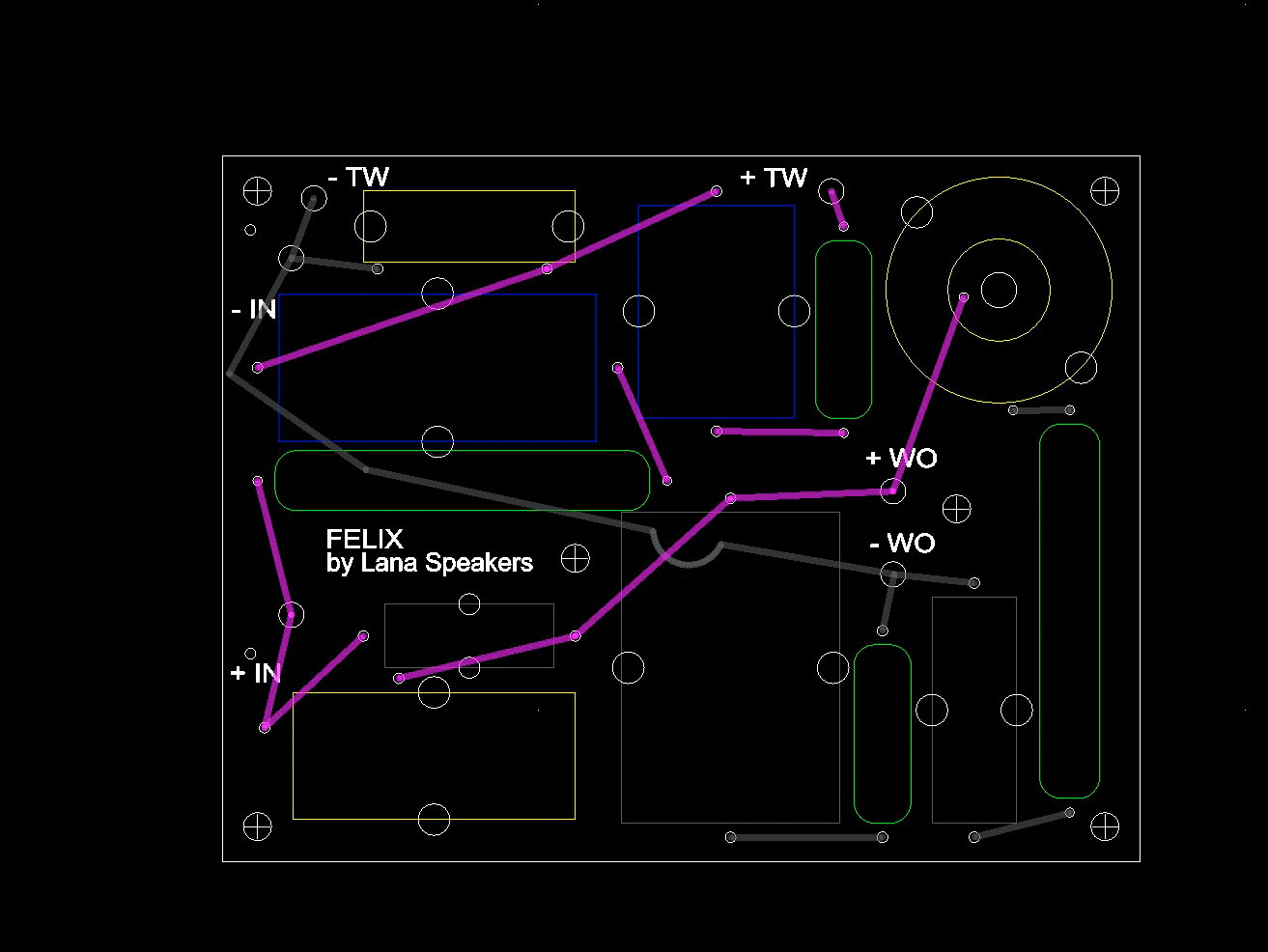
LEFT: Disposition of the components and wiring of them on the crossover plate. All the connections are placed under the plate and except for one all are DIRECTLY connected between the components. This is the plate for the Left Speaker that has the Dayton Amplifier. This is why it has the male Push-on connectors that are for the Dayton left channel speaker output. The 6 holes with the + sign inside the circles are the holes for the screws used to well fix the plate inside the cabinet. RIGHT: Same crossover plate but without the male Push-on terminals, to be use on the right speaker (where we don’t have the Dayton amplifier).
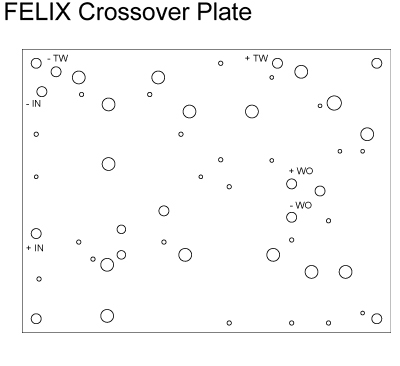
Vectorial file in dwg or pdf with the plexiglass plate sizes and all cut-outs ready to be used.
—–
Photos of the Crossover assembled. All components are of very good quality and are mostly from Jantzen Audio and 1 coil from Mundorf. You will not find this quality components on similar or well higher priced Industrial Speakers! This is one of the advantages of the DIY speakers, few other advantages are that you can make the final finish of the cabinet as you better like and you can fine tune the Middle High and High Frequency to better meet your listening style and better match with your domestic room. Also you can choose the cable you better like for the internal connections, you know How Is Made your speaker and you probably will have your Unique speaker like nobody else. 🙂
Only the Coil in series of the Midwoofer is a Iron Coil Core and even if I prefer the Air Cores this time I had no doubt about using an Iron one. Always need to consider different aspect and keep a balance between the things. I definitely wanted an extremely low DCR which does not alter driver damping factor or add a loss of efficiency, to do this with an Air Core we need to spend much more and we also need a lot of more space as the Air Core would be much bigger then the Iron Coil.
All coils and capacitors, to try avoid the vibrations coming from the cabinet, are decoupled from the 5mm tick plexiglass with a tick rubber. The resistors are “decoupled” and fixed using Blu tack kind material, that it’s also resistant to heat, though just 1 resistor can get “kind of hot”. Of course you can use also Glue Gun or similar but I don’t. I always place a soft material between the cabinet and the crossover plate to reduce vibrations, like Felt or Packaging Foam of about 3/5 mm thickness. – Click to enlarge
THE CROSSOVER SCHEME
Many measuring and listening tests were done and I got to this “final” crossover that I believe is suitable to have a correct sound, a realistic stage reproduction and good general characteristics in the domestic environment.
The measures where made horizontally and vertically from 0 to + – 180 deg., in steps of 10 deg. and in some cases of 5 deg., with some limitations caused by my non Anechoic environment. These many information helped and sad a lot to what we should take care and helped to verify certain acoustical behaviors during the listening sections. Power Response, Directivity Index, Listening Window (+- 30 deg. hor. +- 10 deg. ver.), drivers Acoustic Phase behavior and Impedance Magnitude and Phase were all taken in consideration.
This is a kind of speaker that can be used also on a “desk” (better “a bit” elevated from it) and is suitable also for near listening. It can be perfectly used on stand mounting (that was my main goal) and also with good results it can be placed on a shelf or on a furniture. That is why I also took attention of how the Response and Phase Tracking between the drivers (at 0, 10, 15, 20 deg. horiz.) changes at different listening distances, from 80 to 200 cm, to limit these differences and get a general overall good result. The Tweeter SB Acoustics SB-19ST-C000-4 has a lovely dispersion and this definitely helps a lot to have a more homogeneous high frequencies at different distances and at different angles from the speaker. This is one of the main reason that I choose this Driver.

![]()
Phase tracking between Woofer and Tweeter with Mic at 1 meter at Tweeter axis. As you can see the phase tracking is very good 1 octave under and above the 3000 hz crossover point.
Simulated results at 2 meter from Tw axis at 0 deg: SPL, Listening Window (+-30 Hor. +-10 Ver.), Early Reflections per CTA-2034-A (that shows very good results and also how the 1800 Hz dip will be less preeminent in Room. This behavior is confirmed by the Room response measures at 1/3 Octave ), Power Response, Directivity Index (to Listening Window) and Early Reflections Directivity Index per CTA-2034-A, 1/24 oct.
Measures of the drivers mounted on the cabinet where taken horizontally and vertically from 0 to +- 180 deg in steps of 10 deg. (Click to enlarge)
THE CABINET

I try first an “usual” Vent of 3,5 cm diameter but, as predicted by the calculations, was too small and the air was moving too fast producing a large quantity of noise around all the 40/50 Hz region! Why I try it!? Cause I see many project out there with this or similar 4 inch drivers (or even 5 inch drivers!) made with a 3,5 cm Vent!! Not enough at all if you have a linear +- 5mm Xmax like in this 4′ nice driver! Now the Felix uses a Vent of 5 cm diameter in the bigger side and of 4,7 cm in the smaller side (Vent has a Conical shape). With this bigger Vent the “noise” given by the fast movement of the air in the port is much better! Ok, most of the time they-we choose a smaller vent as we don’t have enough space inside of the cabinet for a longer Vent but we have to be aware that this is a “problematic” thing and is definitely a compromise…

Felix Powered Speaker back panels.
CONTACT ME TO GET ALL DETAILED CONSTRUCTION PLANS AND ACOUSTIC MATERIAL KIND AND SIZES!
Some moments of the first PROTOTIPES CABINET ASSEMBLING with Tibor Szeifert!
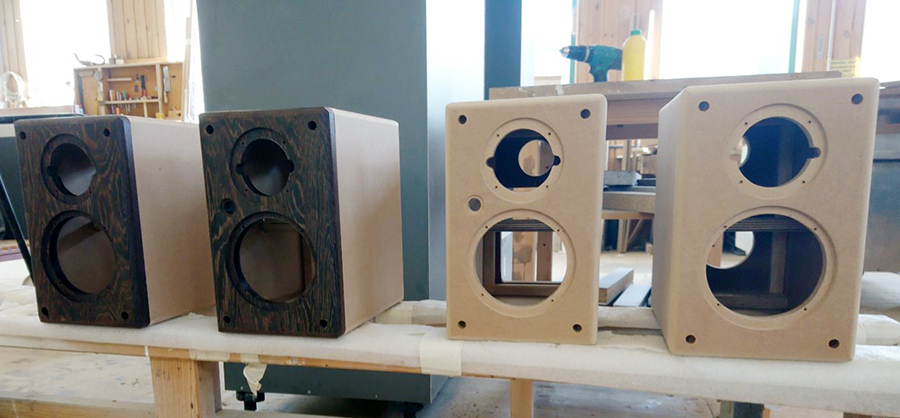
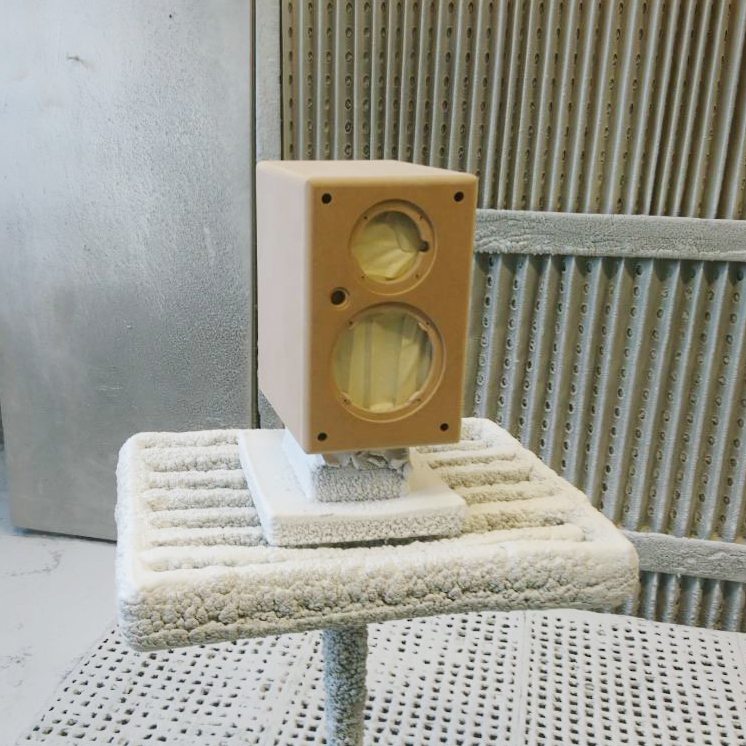

LEFT: Before the painting process. RIGHT: After the painting process in white.
/IT: SINISTRA: Prima del processo di pittura. DESTRA: Dopo il processo di pittura bianca
——-
Here under the very First version of the Powered Felix Speaker that was made for my Daughter Liliana
LEFT: During the painting process, here with a Custom finish (cat drawing) for Liliana. 🙂 RIGHT: Burning in of the drivers.
/IT: Primo assemblaggio per Misure e Test, quí personalizzata con il Gatto per Liliana. 🙂 SINISTRA: Durante la verniciatura. DESTRA: Rodaggio degli altoparlanti.
The name FELIX comes from the drawing that my daughter Liliana wanted on the sides of her speakers!🙂 Of course this is OPTIONAL! Here the left speaker of the FELIX with the very well build Dayton WF60PA WiFi/Bluetooth plate amplifier with a 30+30 watts RMS. (click to enlarge)
/IT: Il nome Felix é quí svelato, visto che mia figlia Liliana ha chiesto di avere il mobile con un simpatico Gatto sul lato.🙂 Qui vedete la cassa sinistra dove é collocato l’amplificatore Dayton WF60PA con WiFi/Bluetooth e da 30+30 watts RMS. (clicca per ingrandire)
First prorotipes! 🙂 The Vent size is being changed to a bigger one!
/IT: Primo assemblaggio per Misure e Test. Le dimenzioni del Reflex sono poi state cambiate! 🙂
